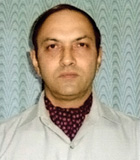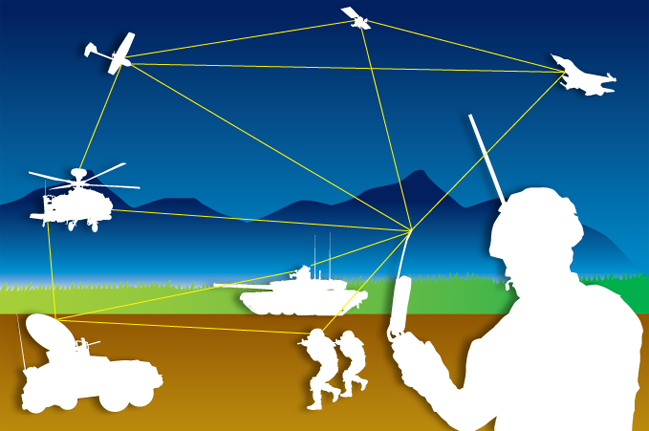INDIAN ARMED FORCES CHIEFS ON
OUR RELENTLESS AND FOCUSED PUBLISHING EFFORTS

SP Guide Publications puts forth a well compiled articulation of issues, pursuits and accomplishments of the Indian Army, over the years

I am confident that SP Guide Publications would continue to inform, inspire and influence.

My compliments to SP Guide Publications for informative and credible reportage on contemporary aerospace issues over the past six decades.
- Prime Minister witnesses 'Bharat Shakti' – a Tri-Services Firing and Manoeuvre Exercise in Pokhran, Rajasthan
- Interim Defence Budget 2024-25 — An Analysis
- Union Defence budget 2024
- Prime Minister Modi Commemorates Indian Navy Day in a Grand Ceremony
- Prime Minister Modi Flies in the LCA Tejas
- New Chapter in India-Italy Defence Ties
- Airpower beyond Boundaries
Developments in Tactical Communications System in the Indian Army

The Tactical Communications System is a revolution in communication technology and is a quantum jump above the technology currently in use. It will be the Indian Army’s futuristic backbone for a digitised battlefield communications network.
In military communications, a Tactical Communications System (TCS) is generally employed within, or in direct support of, tactical forces. It is designed to meet the requirements of changing tactical situations and varying environmental conditions, and provides secure communications, such as voice, data and video, among mobile/static users to facilitate command and control within, and in support of tactical forces. It usually requires short installation times, in order to meet the requirements of frequent relocation.
Today the network-centric warfare (NCW) has come of age and this capability is being established in all modern armed forces of the world as it facilitates situational awareness, collaborative planning and self-synchronisation thus enhancing overall combat power and speed of operations. The Indian Army’s decision support systems are at various stages of development and some have already been fielded.
Network-centricity in future battlefields will be vital for winning wars and this can only be achieved if our communications are digitised, secure, robust (with built-in redundancy) and survivable in the strategic as well as in the tactical domains. The tactical battle area (TBA) primarily has two types of networks which are integrated–static communications and mobile communications. Effective static communications are being acquired by the Indian Army through a new optical fibre cable (OFC) network, being provided to the military since it was made to surrender 3G spectrum. In addition they have the Army Static Communication Nodes (ASCON) all along the international border. Thus while static communications will be networked through OFC and ASCON Nodes, and satellite links, mobile offensive formations will require the development of Tactical Communications Network (TCN) which are presently based on the upgraded Army Radio Engineering Network (AREN) system of communications.

Tactical Communication System – A Digitised Network
In the future, TCS is planned to replace AREN system currently being used in ‘offensive’ formations. The AREN system uses radio relay equipment (commonly referred to as RR equipment) to connect Brigade level headquarters to Division and Corps level headquarters on the battlefield. Based on the type of mobility required, the RR equipment of offensive formations (Strike Corps), whose missions invariably lie across the border is generally mounted on high mobility wheeled vehicles or tracked vehicles while those of defensive formations are based on normal wheeled lorries. Rear of the Corps Headquarters, up to Regional Commands and to Army Headquarters the communications acquire a more static configuration, relying more on OFC, ASCON Nodes and satellite links and less on radio.
The TCS is a revolution in communications technology and is a quantum jump above the technology currently in use. It will be the Indian Army’s futuristic backbone for a digitised battlefield communication network. This system will provide the capacities required for future battlefield communications in the context of network-centric warfare and for facilities such as streaming video transmissions which require much higher bandwidths. It will facilitate the communications from the Corps Headquarters to the troops deployed in the forward areas and to offensive formations which operate beyond the borders in the enemy territory.
The TCS architecture will comprise secure radios, satellite terminal systems and fibre-optic links, and will have modern protection systems against electronic jamming threats. The TCS will be linked with smart antenna systems to support its transmission systems and will be tied to several Army surveillance and intelligence-gathering systems, including the aerostat radars and several unmanned aerial vehicles.
Last Mile Connectivity
As far as the last mile connectivity in the TBA is concerned it cannot be overemphasised as it is meant to empower the soldier who is at the cutting-edge of our forces. The concept of Battle Management Systems (BMS) fulfils this requirement which will be linked to the TCS. It is expected that in the next few years the Indian Army will be able to induct state-of-the-art digital systems which would help in sustaining the momentum and tempo of operations by clearing the fog of war and by presenting a comprehensive battle picture to the commanders at all levels.
Other Armies
China’s military modernisation in the sphere of communications has been based on dissecting enormous Western literature, its scope and progress. Despite this boom, many analysts have paid relatively little attention to recent advances in the People’s Liberation Army’s (PLA) command, control, communication, computer, intelligence, surveillance and reconnaissance (C4ISR) capabilities. The PLA’s growing complement of manned and unmanned aircraft, reconnaissance satellites, and sophisticated ground-based infrastructure comprises the operational foundation of China’s emerging networkcentric military. Much Chinese thinking on C4ISR and military modernisation stems from analysis of the United States’ military performance in both their conflicts in Iraq.
Pakistan Army has already instituted the PATCOM (Pakistan Army Tactical Communications). Under this programme, all Corps have been equipped with hand-held radio sets, VHF vehicles radio sets, low and medium power radio sets, field exchanges and FAX machines. Work is in progress to have a real-time C4I System at all tiers of Pakistan Army.
The British Army has introduced the FALCON trunk communication programme which is being introduced incrementally in British Army. It provides modern, secure communications infrastructure for deployed formations and operating bases. Designed around IP, the system has scalable application meeting needs of an expeditionary force.
The US Army’s current and future tactical communications network is Warfighter Information Network-Tactical (WIN-T), provides secure, agile and survivable end-to-end connectivity and ondemand bandwidth that is dynamically allocated, based on operational priority and precedence among millions of space, air, sea and terrestrial-based fixed and mobile users.
TCS Project Details
Indian Army’s TCS project fielding was originally scheduled to commence in year 2000 (christened TCS 2000) but did not take off. Later, this was given the name TCS 2010 but started moving forward at a snail’s pace. In February 2014 two development agencies (DAs) were selected to develop the prototypes of the TCS. Of the two DAs selected were the state-owned Bharat Electronics Limited (BEL) and a consortium made up of private sector defence companies, including Larsen & Toubro, Tata Power SED and HCL Ltd. Both DAs have been tasked to develop a TCS prototype at the cost of $100 million apiece. The government is to finance 80 per cent of the costs incurred in the prototype development. Once the systems are developed they will be evaluated, tested on the ground, and then one of the two will be selected for production. The entire process, conducted under the Indian Defense Acquisition Council’s ‘Make in India’ procurement category, was expected to take 36 months. It may be noted that the TCS project is worth over $2 billion (over Rs. 13,000 crore) and TCS became the first ‘Make’ programme under the Defence Procurement Procedure (DPP) 2011.
Disputes Have Arisen
It has been reported that procedural disputes have cropped up leading to further delay. The disputes basically involve the following issues:
- Tax exemption incentives.
- Intellectual property rights.
- A level playing field for the private sector companies.
The Larsen & Toubro, Tata Power SED and HCL Ltd Consortium has reportedly requested that it receives the same tax incentives as provided to BEL. The second dispute involves the intellectual property rights (IPR) of the system. Project requires the IPR to be with the Army through MoD. Since TCS would be a dedicated strategic project, the Army wants to ensure the technologies built into the prototype and the final systems are ‘sanitised’, implying these technologies are exclusively developed for the Army and not shared. The developing agencies feel the Army’s case is impractical since it implies the DAs have to take an undertaking from the overseas equipment manufacturers which may not be forthcoming. Moreover the norms for checks on imported technologies would be uniform for both developing agencies. The Consortium’s demand related to IPR must also be seen in light of the ‘Make in India’ call by the Prime Minister which is to transform India into a manufacturing hub, which obliquely implies that products may be sold elsewhere with or without permission on case to case basis.
The private sector DA is also demanding a level playing field. The government has already created facilities in BEL which would be utilised by them free of cost, whereas the private sector consortium would have to make investments that would be added on their bid. Ideally, the depreciation and interest of the Ministry of Defence (MoD)-funded facilities should at least be added on BEL’s bid to ensure a level playing field. This issue is still to be resolved. The Consortium wants the government to address the issue since the production contract is eventually to be awarded to the ‘lowest bidder’ after the successful development of the prototypes. We hope that these procedural disputes will be resolved soon and the project moves forward rapidly.
In the meanwhile the Indian Army’s communication requirements are increasing enormously and becoming more complex in view of the future joint war-fighting doctrines that will encompass joint and integrated operations, involving higher mobility, rapid manoeuvre, quick sidestepping and dispersion and the ever growing demands for battlefield transparency in the form of intelligence, surveillance and reconnaissance (ISR), and the ever present need of commanders at all levels for reducing the timings of the observe, orient, decide and act (OODA) loop.
Conclusion
Technology has changed the traditional thought processes on military effectiveness. Increasingly, modern armed forces are endeavouring to obtain superiority over the enemy by qualitative means through advanced technologies. Developments in imaging, remote sensing, night vision, sensors, precision-guided munitions, stealth technology and above all digital communications and computer networks are compelling the military to adopt new war-fighting techniques. The current ‘silent’ revolution in military affairs, however, has not been accompanied by an examination of its impact on our force structures, organisational aspects, doctrines, quality of leadership, human resource development and logistics. In the Indian subcontinent, future wars will be a hybrid nature, a mix of modern wars and wars of the industrial age. Both will demand knowledge-based warfare techniques and digitised communications.
Illustration: Anoop Kamath





